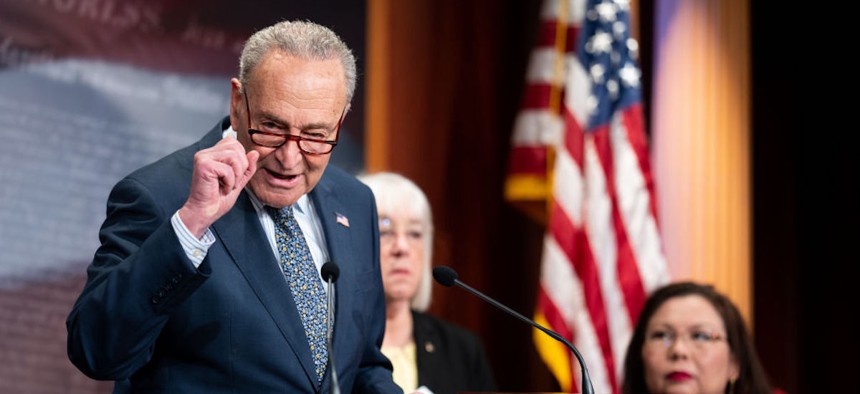
Senate Majority Leader Chuck Schumer of New York said that among the provisions in the spending bills he was “particularly proud of" was one that would ease the uncertainty states have faced around the Special Supplemental Nutrition Program for Women, Infants, and Children, or WIC. Anna Moneymaker via Getty Images
WIC, rental assistance get funding boost in newly unveiled spending bills
But the bipartisan proposals for six bills would cut funding to housing and transit programs.
Bipartisan proposals for six spending bills released on Sunday would increase funding for several programs, including notably providing an additional $1.3 billion through September to help low-income women feed themselves and their children amid rising food costs.
While congressional Democrats refused to go along with making deep cuts to federal spending as sought by House Republicans, they did agree to slash funding for several programs. In exchange, Republicans would increase funding for other significant programs, including rental assistance to keep people housed.
Among the cuts that Democrats agreed to include slashing by $250 million funding for the HOME Investment Partnership Program, the largest grant program for local and state governments to build affordable housing, and shaving off $232 million in funding from the Environmental Protection Agency, which would still receive $9.2 billion. Amtrak would also see the amount it’s allocated to make rail improvements cut by nearly two-thirds.
House Republicans did not get the cuts they were seeking for the clean and drinking water programs—they wanted to reduce funding for the two programs in half, from $1.8 billion to $995 million.
The bills, which the House and the Senate will now vote on this week to prevent a partial shutdown at midnight Saturday morning, will also provide less than public transit agencies sought for capital projects.
The deal would not give Republicans the nearly two-thirds cut they wanted in funding for Amtrak, including slashing money for the Northeast corridor by 85%. The budget will largely remain the same, with congressional leaders shoveling roughly $150 million from the passenger rail service’s most heavily used corridor to national operations.
The bills do cut Consolidated Rail Infrastructure and Safety Improvements, or CRISI, grants from $536 million to $199 million. But the rail service would still receive the $1 billion in grants to improve safety and build passenger rail that was included in the Infrastructure Investment and Jobs Act.
Despite reaching a tentative agreement on the first six bills needed to avoid a shutdown, Congress still has six other bills to negotiate before March 22, including for human services and disaster relief programs.
The second batch of bills will also take up other key issues including whether to provide cities with funding to house asylum-seekers and places of worship with money to protect themselves from hate crimes. Congress will also have to decide if they will continue the $30-a-month subsidy that low-income households have been receiving to pay for internet service.
The Federal Communications Commission on Thursday warned that as many as three-quarters, or more than 17 million, of the 23 million households participating in the Affordable Connectivity Program could see disruptions to their internet access should the program end.
The agreement on the first six bills is expected to be opposed by House conservatives who may try to oust Republican Speaker Mike Johnson as they did with Kevin McCarthy after he cut a bipartisan deal with Democrats last year to prevent the nation from defaulting on its debt.
However, Republican House Appropriations Chairwoman Kay Granger of Texas touted the agreement on Sunday, saying in a statement that the bills “achieve what we set out to do” by making “targeted cuts to wasteful non-defense programs.”
Democrats, meanwhile, applauded having staved off the amount of cuts sought by Republicans.
Food Assistance for Women and Children
Democratic Senate Majority Leader Chuck Schumer of New York said that among the provisions he was “particularly proud of" was one that would ease the uncertainty states have faced around the Special Supplemental Nutrition Program for Women, Infants, and Children, or WIC. The Agriculture Department has said that because of an unexpected increase in women signing up for the program and the rising cost of food, it will fall $1 billion short of what it needs to fully fund the program through the end of the fiscal year on Sept. 30. It also said it will run out of cash in August.
At least one state, North Carolina, told Route Fifty last week that it has started furloughing or reducing the hours of part-time workers to save enough money to help all of those seeking assistance. A spokesperson for the North Carolina Department of Health and Human Services said without more funding it would have to consider turning low-income women and their children away.
“Given the uncertainty of funding at the federal level, we continue to monitor program expenditures on a regular basis to determine if we need to take additional measures like implementing a waitlist for new participants or making immediate program cuts which would limit access to healthy food for children and families,” the spokesperson said.
“As someone who relied on food stamps when my family fell on hard times, I know full well that investing in WIC doesn’t just feed moms and babies—it’s an investment in our country’s future,” said Sen. Patty Murray, the Democratic chairwoman of the Senate Appropriations Committee. ”WIC saves lives and it also saves money.”
Housing
In addition to increasing funding for WIC, the proposals would also provide substantially more money for the Department of Housing and Urban Development’s tenant-based rental assistance program. Its budget would increase by nearly $5 billion, bringing the total to $32 billion.
Half of Americans are spending more than one-third of their income on housing costs—and many spend at least 50%, according to a study from Harvard's Joint Center for Housing Studies. It’s an issue that was exacerbated last year by the end of the emergency rental assistance program that kept many families housed throughout the pandemic. For every household that receives a Section 8 housing voucher, there are three eligible households that don’t.
The deal “averts the risk of losing vouchers, which is a major success,” said Sarah Saadian, senior vice president of public policy and field organizing at the National Low Income Housing Coalition, in an email.
An additional $20 million would be provided for so-called Yes In My Backyard grants for state and local governments to examine how zoning changes can increase the nation’s housing supply. Advocates argue that single-family zoning contributes to rising housing costs by restricting the creation of more units.
However, the proposal does include deep cuts to other housing programs, including the HOME Investment Partnership Program, which will see its budget decrease from $1.5 billion to $1.25 billion.
House Republicans had sought to eliminate $350 million from the Choice Neighborhoods program, which provides funding to replace aging HUD-assisted housing with mixed-income housing. While it would still receive funding under the proposal, the amount it gets would be slashed to nearly a fifth at $75 million.
“Overall, the bill provides significant HUD resources in a year that was incredibly challenging, given the Fiscal Responsibility Act, which strictly limited the amount of funding available for domestic programs,” Saadian said, referring to the debt deal between President Joe Biden, Senate Democrats and House Republicans to leave overall spending at roughly the same levels.
Water Infrastructure
Meanwhile, even though Republicans did not get the cuts they wanted to the Clean Water and the Drinking Water State Revolving Funds, about half of the $2.8 billion for the programs would be spent on earmarks requested by members of Congress for the areas they serve. The National Association of Clean Water Agencies has argued such earmarks take away the ability of states to determine where the funding is most needed.
Water advocacy groups said they were glad negotiators did not agree to deep cuts, but the funding is not nearly as much as states and local governments need.
“Overall about what we expected,” said Nathan Gardner-Andrews, chief advocacy officer for the National Association of Clean Water Agencies. "Definitely doesn’t fund clean water programs at the level we need, but the fact there were no significant cuts is a starting point moving forward.”
“Federal funding accounts for just 5% of all investment in water infrastructure across the country—a drop in the bucket compared to the estimated $1 trillion needed over the next 25 years to return these critical systems to a state of good repair,” said Mae Stevens, CEO of the American Business Water Coalition.
Transportation
The Federal Highway Administration’s Highway Trust Funds would see an increase as well, from more than $58 billion to nearly $61 billion.
The negotiators did not agree to eliminate so-called RAISE grants as House Republicans wanted. But the funding for the program, which awarded grants to 166 transportation projects last year—nearly two-thirds of them in historically disadvantaged communities or areas with persistent poverty—would be reduced from $800 million to $345 million. The proposal would more quickly distribute $1.5 billion in separate infrastructure act funds that the program was not set to receive until next year.
Transit agencies, meanwhile, would receive $13.9 billion “to expand bus fleets and increase the transit state of good repair,” according to the proposal. But they would only get $2.4 billion in capital investment grants “to create new transit routes.” While that's more than the House proposed, it is far short of the $4.6 billion the transit agencies asked for.
“These critical infrastructure investments help communities, large and small, design and construct new bus rapid transit, commuter rail, subway, and light rail systems and extensions. Communities are seeking more than $45 billion in grants,” the American Public Transit Association said in an advocacy letter to congressional leaders.
Kery Murakami is a senior reporter for Route Fifty, covering Congress and federal policy. He can be reached at kmurakami@govexec.com. Follow @Kery_Murakami
NEXT STORY: These are the 8 biggest agency and program reforms in the first FY24 spending bill



